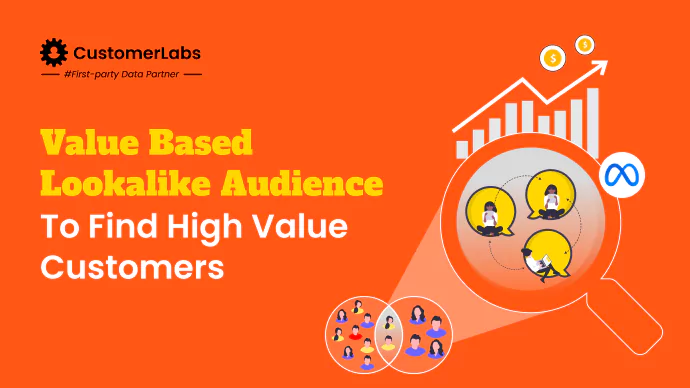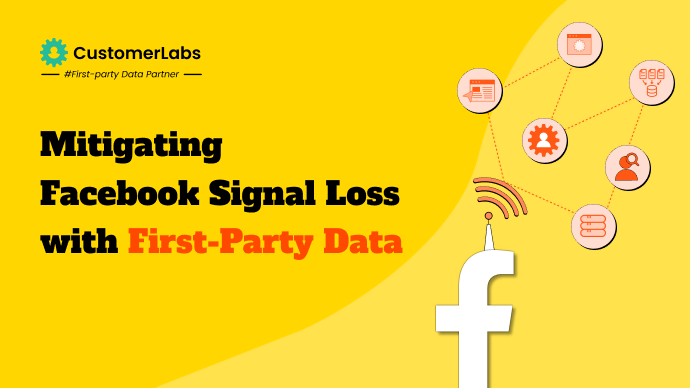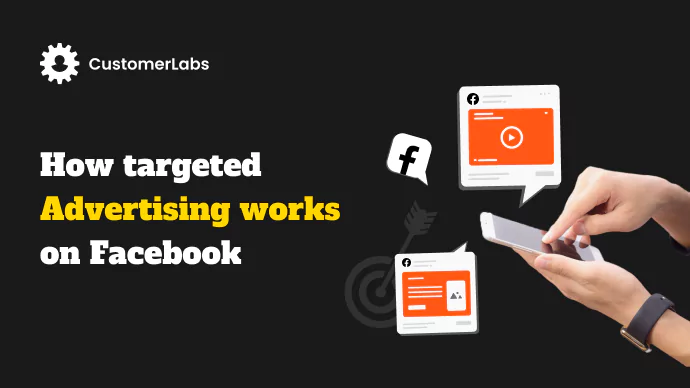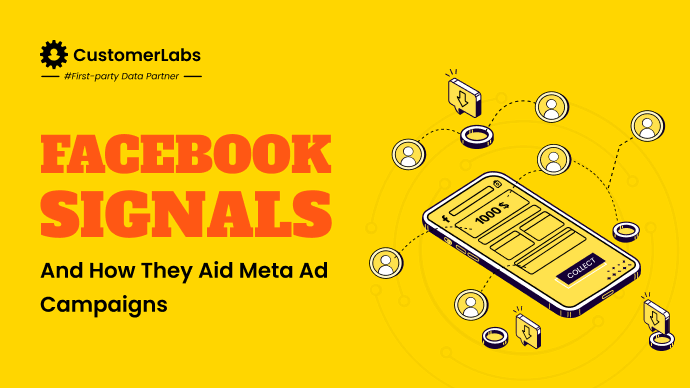
Facebook signals is a topic worth discussion among marketers across the world, especially after the iOS updates (iOS14, iOS17 update), data privacy regulations such as GDPR, CCPA, etc., and third-party cookie deprecation from major browsers.
This blog explains in detail about Facebook Signals and how they help Meta Ads, how audience signals are collected by Meta, the changing landscape of facebook signals, impact of before and after the iOS-era or the data privacy updates on signals & marketers, and the best practices to mitigate the audience signal loss on Meta Ads.
Delve in to reinforce your amygdala with valuable information about Facebook Signals to maximize your ad campaign performance and stay ahead in the cookieless future.
What Are Facebook Signals?
Facebook Signals are the intricate data points about your customers’ behavior, actions and any other interactions with your business on your website. They form the foundation of every marketing strategy as it is crucial for any business to understand their customers.
Every single action the user makes is crucial to map the entire customer journey. Facebook signals contain all these behavioral information of the users along with the user details such as name, email address, phone number, location, and ip address for known users.
For those users who do not login to the website, Facebook’s signals contain ip address, device id, browser id, fbc, fbp, etc., parameters, which help map the user journey for these anonymous website visitors.
How Facebook Signals Help Meta Ads?
Facebook signals have within them valuable user data that give complete information about the users. This data powers the machine learning algorithms by acting as a fuel to run the Meta ad campaigns at an optimized cost effectively.
Signals are primarily the basic infrastructure for these ad algorithms to understand the customer/user based on their journey and target the right users with relevant ads at the right time.
The better the data you provide the ad algorithms with, the better is the performance of your ad campaigns.
How it actually works in the background is;
- You send the facebook signals without loss to the ad platform,
- Meta will process these signals using the machine learning algorithms,
- The ad algorithm will understand the customers’ behavior and optimizes the ad campaigns using the signals
- Meta will be able to target the right people with the right ads in the most cost-efficient way.
- Finally drives the maximum performance for all your ad campaigns
Facebook signals help the ad platform with better quality lookalike audience, dynamic ad campaigns, retargeting, attribution, and overall enhanced ad campaign performance.
How Facebook Gets Signals From Your Business?
To collect Facebook signals, Meta has its own infrastructure built and pixel is one of the most used for the same. Pixel is a code snippet that helps you collect all your website visitor data and send it to ad platforms.
Pixel powers up the machine learning algorithms of Meta Ads platform with all the relevant customer behavior data including the parameters. It’s a simple easy-to-use tool that helps you track all the actions a user takes on your website such as add to cart, page view, etc., once placed in the header of your website.
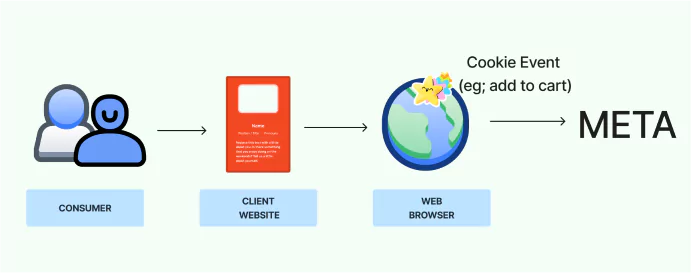
Pixel is just one of the tools. The other powerful tools that help you send signals to Meta Ads include Conversions API and Advanced Matching.
Conversions API sends the data directly from the server-side and Advanced Matching that helps you reach a larger custom audience, leading to better attributed conversions, and reduces the cost per action.
What’s Happening To Facebook Signals?
The data privacy regulations such as GDPR (General Data Protection Regulation), CCPA (California Consumer Privacy Act), and other country laws, software updates such as iOS14/iOS17, Android14, third-party cookie deprecation from various browsers among others have reduced the effectiveness of Meta’s pixel.
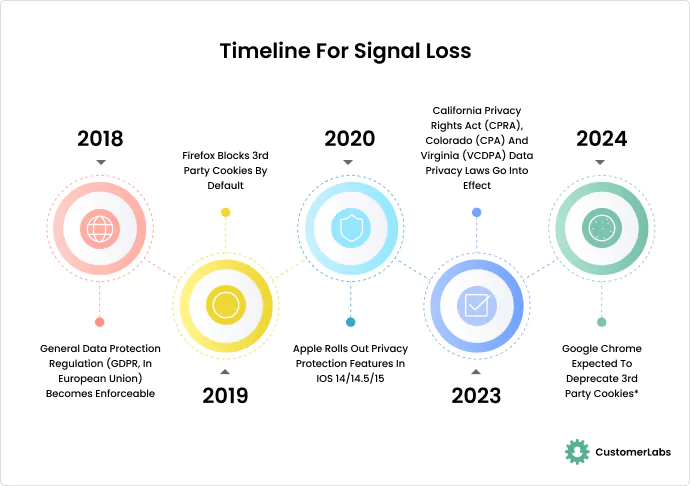
This ineffectiveness of Meta’s pixel due to the above listed set of problems has caused signal loss to the ad platform. Facebook Signal loss has led to lack of complete customer journey to the machine learning algorithms of Meta Ads platform. When the algorithm is unable to identify the right users for the right messaging, it messes up the ad campaign performance, leading to poor results.
Impact Of Signal Loss On Marketers
Signal loss on Meta Ads has limited the data that Meta’s ad algorithms were earlier able to process. This has impacted the ad campaigns performance in a negative way.
The below image illustrates both how signals help and what happens if there’s signal loss. The steps 1, 2, 3, 4, and 5 contribute to better ad campaign performance if there’s no signal loss.
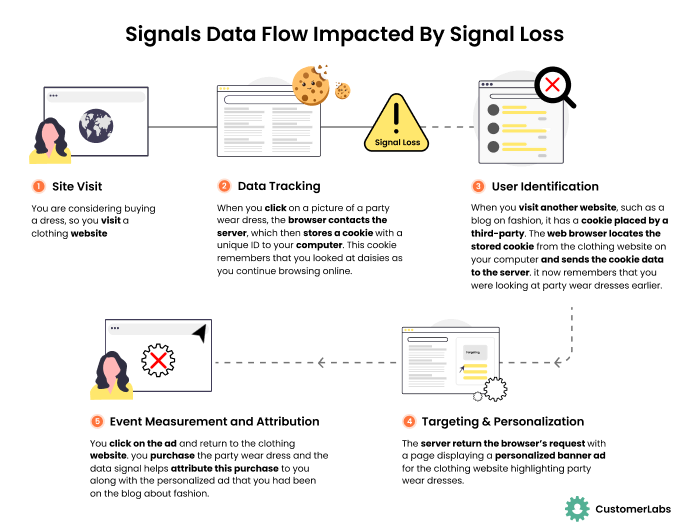
The dotted line in the above diagram represents the lack of Meta’s ability to perform user identification, targeting & personalization, and event measurement & attribution.
Facebook signal loss has caused much trouble to marketers taking a hit on their overall ad campaign performance.
- The EMQ (event match quality) dropped to poor/ok*
- The custom audience match rates dropped to around 25 to 30%*
- Ad campaigns’ scalability took a hit due to lack of quality audience with the ad platform.
*Based on marketers’ experiences after the data privacy updates kicked in.
Best Practices To Use Facebook Signals
Meta recommends marketers to use Pixel with manual advanced matching & automatic advanced matching together + Conversions API with offline data. So this is how it looks
Conversions API with Pixel using Manual & Automatic Advanced Matching, and offline data (if you have any offline events to be sent to Meta). This is the ideal way to leverage the full potential of Facebook Signals.
Now how do you do that?
The recent comprehensive report by Deloitte on first-party data strategies have illustrated the perfect technology stack that any marketing team needs. The flow chart clearly shows how you can send signals to Meta Ads without any loss.
Here’s how it works:
Have all the sources of first-party data (website, CRM, in-store, etc.) connected to a CDP (customer data platform), and then activate your own first-party data (the audience signals) by sending them across to ad platforms such as Google Ads, Meta Ads, etc.
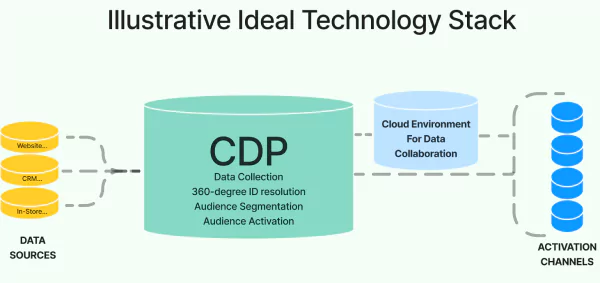
A CDP like CustomerLabs can help you with proper conversion tracking, Conversions API, Google Offline Conversions API, be one point of source to collect your first-party data, create a 360-degree profile, segment the audience as you wish, and activate the audience across multiple platforms such as Meta Ads, Google Ads, Google Analytics, etc.
Want to know in detail on how to mitigate signal loss?
Read this blog on Mitigate Signal loss on Facebook using First-party data to know how to mitigate signal loss and navigate the privacy-filled future offering personalization.

